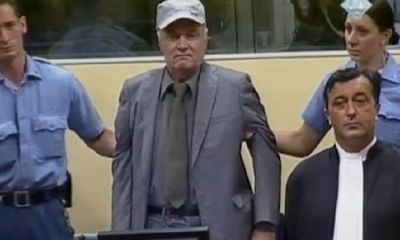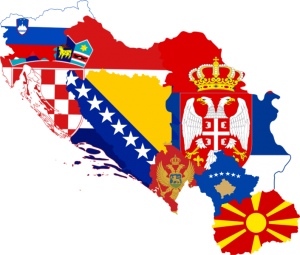
Views: 3121
General Ratko Mladic’s arrest and his extradition to the International Criminal Tribunal for the former Yugoslavia satisfied the prerequisites for Serbia’s membership in the European Union. As expected, the western media have tagged the defendant as the “Butcher of Bosnia” and piled on as many charges against him as possible, thereby masking NATO’s role in Yugoslavia. But there can be no reconciliation without truth, which, as Slobodan Despot observes, is far more complex than the Manichean account given.
Ratko Mladić did not serve his country well by hiding from justice for all these years, but his late capture may allow a more serene evaluation of the tragedies in which he was the protagonist, an evaluation that would have been impossible had the trial been held in the immediate post-war period.
At the time when the ICTY indictments were issued, the West unanimously designated a single culprit: the Serbs. Since then, things have changed.
Foreign interference in the conflict, especially by the Americans, has been widely studied and analysed (see the books by Jürgen Elsässer and Diana Johnstone). Similarly, Jacques Merlino, Noam Chomsky, Edward Herman & David Peterson and others have conclusively shown how media manipulation on a very large scale was used to influence public perception of the war.
Protagonists presented until recently solely as victims have been accused or convicted of the same crimes as were the Serbs. Tudjman’s Croatia, in “Operation Storm”, in the summer of 1995, massacred thousands of Serbs and ethnically cleansed 250,000 others from Krajina. Hashim Thaci’s KLA in Kosovo massacred Serb civilians and trafficked their organs. Bosnia, led by the late Alija Izetbegovic, president-elect of the Muslim community and theoretician of Islamic fundamentalism, was proved to be a bridgehead for the Mujahedeen, first Saudis and then Iranians, and a haven for terrorists. In fact, most of the terrorists responsible for the attacks of September 11, 2001, London and Madrid had stayed in Bosnia and Bin Laden himself had a Bosnian passport issued in 1993.
For those who have the courage to remember, the period when accusations of genocide were made against Ratko Mladić and his political superior, Radovan Karadzic (whose capture and on-going trial in The Hague seems to have already been forgotten) was marked by militant anti-Serb propaganda by the West. From the perspective of 16 years later, this propaganda now appears irrational and extravagant.
It will be difficult to present General Mladić as a wolf who attacked innocent sheep. At the arrest of each new Serbian official, the International Community and the media jubilantly assured us that guilt would be demonstrated but they were remarkably discreet once the trial began. The trial of Milosevic had completely disappeared from the screen by the time he died, that of Seselj, although fantastic, was hidden and then fizzled out, and nobody is in the least interested in Karadzic’s trial. Each of these protagonists, in his defence, has accused the people who set up the court trying them of (at the least) partiality and cynicism.
Hopefully, the Mladić trial will be an exception to this rule. Hopefully it will seriously examine the entire context that led to the massacre of Srebrenica and how a vulgar “tit-for-tat” between two armies was transformed by rhetoric into something far worse: genocide.
The widespread and abusive use of this word in Western and Bosnian-Muslim descriptions of events of July 1995 shows that the main aim of its use is to intimidate. When we compare this usage with what happened at Nuremberg and the legislation it led to, it becomes clear that the ICTY wants to prevent any rational examination of Srebrenica. Astoundingly, the definition of genocide established at Nuremberg excludes the Srebrenica massacre since the latter targeted only men of fighting age (in spite of the “men and boys” ritually referred to), and not a community as such.
When I participated in the programme Forum of Radio Suisse Romande, of May 26, 2011, the journalist Philippe Revaz asked a straightforward question to Carla del Ponte, former prosecutor of the ICTY:
“Carla del Ponte, is this genocide?“
The response of the magistrate is significant:
“I say genocide, because, uh, we already had convictions for complicity in genocide, and already we have had confirmation that it was genocide in Srebrenica by the Court of Appeal Tribunal [ICTY] “.
It is highly significant that Ms. del Ponte justifies the term not by describing what happened or by using a universally accepted definition of this crime, but by recourse to the jurisprudence of her own court. “I say that X has committed genocide because someone else has already been sentenced for complicity in genocide”. The tautology borders on the absurd!
Mladić’s judges would make a real service to justice for mankind if they avoid the tautologies and absurdities above. To do this, they need to try and answer, calmly and without bias, a whole series of questions that have accumulated over the last 16 years:
Why were the Muslim forces of Naser Orić allowed to use the demilitarized zone of Srebrenica, between 1992 and 1995 as a base for their murderous forays into the surrounding Serb villages, directly under the eyes of the Dutch UN peacekeeping battalion?
Why did the ICTY release Naser Orić without investigating the well-documented – by a medical examiner – massacre of 3,250 Serbs in the vicinity of Srebrenica?
What is the value of the testimony of key witness Dražen Erdemović, a Croatian mercenary, released in exchange for his damning testimony – unsupported by the facts – of mass executions of Muslim prisoners?
Why did the United States, via the voice of Madeleine Albright, wait until August 10th 1995 to “reveal” the massacre of Srebrenica, even though they claimed to have taken satellite photographs of the crime in real time?
Why have these images never been shown?
What is link between the press conference on 10 August, which focused world attention on Srebrenica, and “Operation Storm”, which was initiated in neighbouring Croatia on August 4, in which a similar number of Serbs, including women and children, were murdered or disappeared?
On 15 April 2011, the ICTY convicted two Croatian generals for this operation, described what took place as ethnic cleansing planned at the highest level. Yet “Operation Storm”, as we now know, was carried out with detailed support of U.S. officers working with a sub-contractor of the U.S. forces, the MPRI.
The credibility of the U.S. administration has collapsed since the lies about weapons of mass destruction that justified the invasion of Iraq were revealed. Suspicions that were unthinkable in 1995 are in common currency in 2011.
General Mladić, cordially appreciated by his peers in NATO during the Bosnian war, is not only a suspected war criminal. He is also a key witness to a frenetic period when it was forbidden to think.
Announcing the arrest of Mladić, Serbian President Boris Tadic reiterated that it is important to act on the results of the investigation by Dick Marty on organ trafficking adopted by the Parliamentary Assembly of Council of Europe – conclusions that the International Community seems to have difficulty translating into actions.
The trial of the last warlord of the 90s is also the last chance to bring real justice for all the victims of those years of hatred, rather than a limited justice based on retribution and re-education mainly directed against the group summarily identified as “guilty”.
Originally published on 2011-06-06
Author: Slobodan Despot
Source: Voltaire.net
Read our Disclaimer/Legal Statement!
Donate to Support Us
We would like to ask you to consider a small donation to help our team keep working. We accept no advertising and rely only on you, our readers, to keep us digging the truth on history, global politics and international relations.











